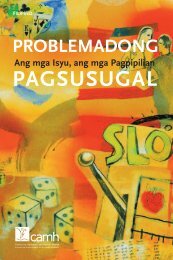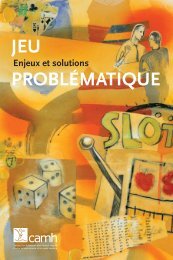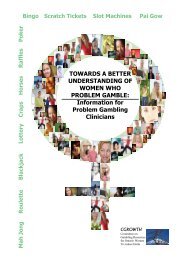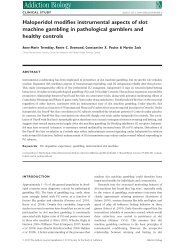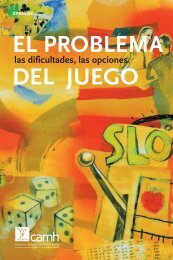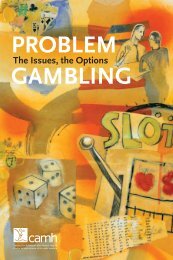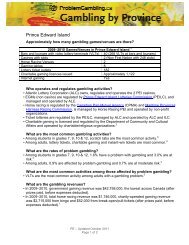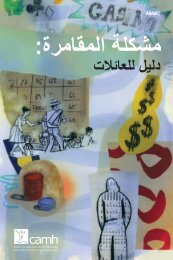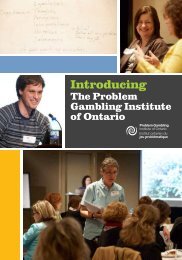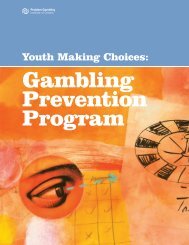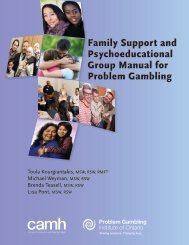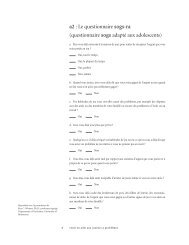Probability, Random Events, and the Mathematics of Gambling
Probability, Random Events, and the Mathematics of Gambling
Probability, Random Events, and the Mathematics of Gambling
You also want an ePaper? Increase the reach of your titles
YUMPU automatically turns print PDFs into web optimized ePapers that Google loves.
player’s chances <strong>of</strong> winning. At <strong>the</strong> same time, <strong>the</strong> more tickets purchased, <strong>the</strong> greater <strong>the</strong><br />
average expected loss. One thous<strong>and</strong> tickets means 1,000 opportunities to win, so that <strong>the</strong><br />
chance <strong>of</strong> winning Lotto 6/49 goes from 1 in 14 million to 1 in 14,000. However, because <strong>the</strong><br />
expected return is nearly always negative, <strong>the</strong> player will still lose money, on average, no<br />
matter how many tickets <strong>the</strong> player purchases (see “Playing Multiple H<strong>and</strong>s, Tickets or Bets”<br />
in Part 1.5, “Games <strong>and</strong> Systems”). This is true whe<strong>the</strong>r <strong>the</strong> player buys several tickets for <strong>the</strong><br />
same draw or one ticket for every draw. Adding more opportunities (e.g., more tickets, bingo<br />
cards or slot machines) increases a player’s chance <strong>of</strong> a win, but does not allow him/her to<br />
beat <strong>the</strong> odds.<br />
Combinations<br />
One final aspect <strong>of</strong> probability is <strong>the</strong> fact that <strong>the</strong> likelihood <strong>of</strong> two events occurring in<br />
combination is always less than <strong>the</strong> probability <strong>of</strong> ei<strong>the</strong>r event occurring by itself. Friday<br />
occurs, once every 7 days (1/7) <strong>and</strong> <strong>the</strong> 13th day <strong>of</strong> <strong>the</strong> month comes once per month (about<br />
1/30 on average). Friday <strong>the</strong> 13th, however, only occurs roughly once in 210 days (7 x 30) or<br />
once or twice per year.<br />
To compute <strong>the</strong> joint probability <strong>of</strong> an event, multiply <strong>the</strong> probability <strong>of</strong> each <strong>of</strong> <strong>the</strong> two<br />
events. For example, <strong>the</strong> chances <strong>of</strong> rolling a 4 with a single dice are 1/6, or 16.7%. The<br />
chances <strong>of</strong> rolling a 4 two times in a row are: 1/6 x 1/6 = 1/36 (2.78%). The chances <strong>of</strong> rolling<br />
a 4 three times in a row is 1/6 x 1/6 x 1/6 = 1/216 (0.46%). It is important to note, however,<br />
that <strong>the</strong> joint probability <strong>of</strong> two events occurring refers only to events that have not happened<br />
yet. If something has already happened, <strong>the</strong>n its chance <strong>of</strong> occurring is 100% because it has<br />
already happened. If <strong>the</strong> number 4 came up on <strong>the</strong> last two rolls, <strong>the</strong> chances <strong>of</strong> rolling<br />
ano<strong>the</strong>r 4 are 1/6 not 1/216 because <strong>the</strong> new formula is 1 x 1 x 1/6, not 1/6 x 1/6 x 1/6. Each<br />
event is an independent event. In addition, <strong>the</strong> chances <strong>of</strong> any number coming up twice in a<br />
row are 1/6, not 1/36. This is because <strong>the</strong>re are six possible ways (opportunities) <strong>of</strong> getting <strong>the</strong><br />
same number twice in a row: (1/6 x 1/6) x 6 = 6/36 = 1/6.<br />
It is <strong>the</strong> cumulative <strong>and</strong> multiplicative aspects <strong>of</strong> probability that lead people to overestimate<br />
<strong>the</strong>ir chances <strong>of</strong> winning. People tend to underestimate <strong>the</strong> chance <strong>of</strong> getting one or two <strong>of</strong> <strong>the</strong><br />
same symbols on a slot machine because <strong>the</strong>y do not take into account <strong>the</strong> number <strong>of</strong><br />
opportunities. A number <strong>of</strong> studies have shown that people can unconsciously learn<br />
probability through experience (Reber, 1993). Suppose <strong>the</strong> chances <strong>of</strong> getting a diamond on a<br />
slot machine are 1 in 32 on each <strong>of</strong> three reels. The chance <strong>of</strong> getting at least one diamond is 3<br />
(<strong>the</strong> number <strong>of</strong> reels) x 1/32 = 9.4%. That is, <strong>the</strong> player will see a diamond on <strong>the</strong> payline<br />
roughly one time every 10.6 spins. But <strong>the</strong>ir chances <strong>of</strong> getting three diamonds would be 1/32<br />
x 1/32 x 1/32 = 1/ 32,768 = 0.003%. Because we occasionally see one (9.4%) or two (0.3%)<br />
8




